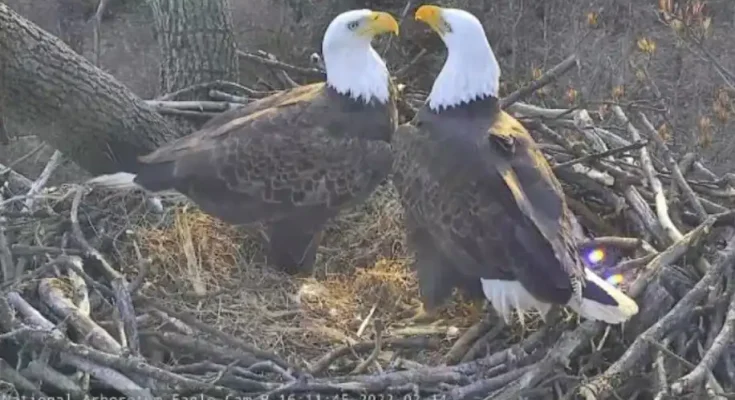It’s not clear how many eggs there are. Experts plan to do their annual “eagle flyover” in a helicopter soon for a bird’s-eye view of the nest, which overlooks the Langston Golf Course, to try to learn more. They had planned to conduct the flight Thursday but canceled due to high winds.
Bald eagles have a 34- to 36-day gestation period, so experts estimate the egg(s) will hatch between April 9 and 11. Rauch said this spring, the birds are a bit late in laying eggs, and he believes it’s in part due to the chilly winter weather in the region this year.
“It’s pretty impressive,” Rauch said. “It shows bald eagles have really come back to the area strong.”
Bans on pesticides and the passage of the Endangered Species Act in the 1970s have helped boost the country’s bald eagle population, along with improvements to their habitats and clean air and water initiatives, experts said. Bald eagles were removed from the endangered species list in 2007, but remain protected under several federal laws. Nationally, there are 71,000 breeding pairs of bald eagles in the Lower 48 states — a major comeback from the 1960s when there were less than 500 breeding pairs, according to the U.S. Fish and Wildlife Service.
The bald eagle became the national bird last December when President Joe Biden signed a bill making it official.
In D.C., Mr. President and his first partner — First Lady — met in December 2013 and built a nest that winter near the arboretum’s azalea garden. It marked the first time a bald eagle pair had set up a nest at the property in 68 years.
“Bald eagles started to recolonize in downtown areas like D.C.,” Rauch said. “They seem to have figured it out. They are urban eagles now. They can handle issues of air traffic and noise.”
Mr. President, also known as Mr. P, and First Lady had their first eaglet in 2014, and went on to have a total of eight hatch. They had their last chick in the nest in 2018, before it died of West Nile virus.
The eagle couple had a social media following thanks to a 24/7 live feed of a web camera in a tree near their nest.
Bald eagles typically mate for life as long as they’re successful having chicks together. But if there’s a problem, they’re known to switch up and find new partners.
The first eagle couple’s relationship became tumultuous after they failed to produce more offspring a few years ago. First Lady would take off in warmer months and come back in the fall, and during one of her trips away, Mr. P had other female suitors in the nest, experts said.
At times, First Lady would chase off her husband’s suitors with her “talons out,” flying toward the nest at 50 to 60 mph, Rauch said. The two reconciled, but she laid no more eggs. Then on Valentine’s Day 2022, she flew the coop for good. The next day, a younger female — who eagle fans nicknamed Lotus, short for Lady of the United States — moved in.
Lotus became a mom in 2022, and the couple has successfully hatched eaglets for the last few years.
About two years ago, the pair moved to a new nest overlooking the golf course, about a mile as the eagle flies, from their old nest. Experts decided not to install another camera at their new abode, which is in a more secluded, wooded area of the arboretum that is farther from trails and harder for humans to see.
It’s not uncommon for eagles to use a nest for several years, then move and build a new one. Sometimes predators run them out, a tree dies, or they feel the nest is not sturdy enough. The cameras, which ran on solar power, are difficult to set up and maintain, experts said.
Lotus is now 8 years old, and Mr. P is believed to be 16 or 17 — a bit on the older side for bald eagles, which typically live to be about 20, Rauch said.
Despite his age, Mr. P’s “great at defending the nest. He’s focused and chases off hawks and goes, and hunts, and fishes all the time. But he will also come and spell her to protect the nest, so she can go out and feed herself,” Rauch said.
“He’s been a good partner.”




